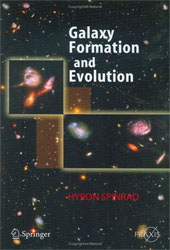
Digital cameras are all the rage today, but one that’s limited to a 12 by 12 array isn’t going to carry much weight. Such slight detail prevents distinguishing people’s faces or much else. Yet as Hyron Spinrad describes in his book Galaxy Formation and Evolution, often this is the broadest amount of information available for whole galaxies. In spite of this, he shows that there’s no shortage of interpretations, even with such slight references.
Our solar system lies in an adjunct arm of the Milky Way galaxy. Our galaxy spans many light years in all directions and not long ago it was thought to define the limits to our universe. Thanks to better instrumentation and advances in the knowledge of physics, we know that our galaxy is one of countless others that expand to no known limit in extent. As far as we see, galaxies in a myriad of shapes sprinkle the darkness between stars. But with humankind’s aptitude for classification, we’ve been busy searching for and sorting galaxies as they make themselves known. Using Hubble’s tuning fork diagram, galactic emission lines, and our understanding of nucleosynthesis, we can group galaxies and postulate their evolution. That is, having seen the beginning of time via COBE and WMAP, we can guess on the sequence of events that led to the night skies we see today.
Spinrad’s aim in his book is to summarize recent discoveries and physically-based theories for the research professional or learned amateur. As such he delivers. He starts with an assessment of nearby galaxies. From these, he sets expectations on size, shape, speed and emission types and rate. Then, from a copious selection of papers and presentations, he extends the review to the farther reaches. Reciting a potpourri of techniques and tricks, he presents the works of many other researchers. Each section of each chapter takes a new look at the challenge. From baryon density to the Lyman alpha optical depth to the luminosity of active galactic nuclei, he considers how measurements and expectations combine together to build a plausible galactic morphology.
This book is not for the scientific faint of heart. It has a wealth of detailed information written with the assumption that the reader has strong knowledge of the field. Classifications are key and most seem to consider results from statistical binning. Often the statistics is based upon little data, whether images are 12 by 12 pixels or only ten’s of images appear for a given z redshift value. Thus, Spinrad makes judicious use of the word ‘probably’. But building on experience and using the results of ever more detailed sky surveys by ever more capable instruments he shows how a certain sense or rhythm occurred as high density regions evolved into stars, galaxies and clusters. As well, from this we can see where we in the Milky Way Galaxy are heading to.
Spinrad does bring a broad range of detail into the question of galactic formation, but his book isn’t smooth. Reading it is like reading conference proceedings; the topics are relevant but a storyline is missing. All his references come from recognized astronomy journals and most referrals are to editions from within the previous six years. This lends the belief that the content is recent, applicable and valid. Perhaps the targeted research professional would find this book of value, but it’s hard to see how it adds to the information already presented in the journals.
The expectations of the reader’s knowledge also quickly becomes apparent. Acronym’s abound but no ready list aids the reader to recover their meaning. Equations are sprinkled throughout but are seldom used or explored. Further, with a few striking editorial errors and an index that is on occasion incorrect, the book gives the impression of having been rushed to publication. In a sense, it is more like a collection of review notes that the author made and then quickly submitted to the publisher perhaps in the hopes of besting others. If the reader is looking for a particular viewpoint of this data, this book would be of value, but don’t expect a detached, well planned perspective.
Astronomy is a demanding research field. Instrumentation from all over the Earth’s surface and positioned high above our planet detect the slight emissions from far away sources. Hyron Spinrad in his book Galaxy Formation and Evolution summarizes much of the current work of scientists who analyze the received data and then use results to piece together likely processes. Though far away, the galaxies in our universe are becoming clearer.
Review by Mark Mortimer
